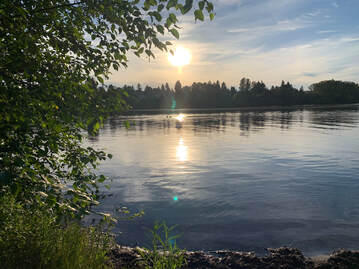 The water is calling! The water is calling! It’s finally that time of year and the warm weather is here! Are you a triathlete who needs to transition from the pool to the open water? Do you simply enjoy swimming for a workout or recovery and want to move your workout outside while the weather is nice? Either way, our local lakes in the Pacific Northwest are just finally comfortable to swim in. Let’s get going! What do we need to think about before heading out for an open water swim? Even for seasoned swimmers, open water swimming can create a lot of anxiety and stress. There are other swimmers and other recreational water sports, boats, wildlife, greenery, and waves. There are no black lines and you can't put your feet down. For some, it can be daunting and even a little anxiety producing. What are some basic considerations when getting back into that open water? No Lines, No Worries Pool swimming is a controlled environment where it is easy to find a rhythm. Even when the pool is crowded, you can usually jump in and start to swim in many, many little circles. There is a handy black line to help you go straight and every 25 yards (maybe 50 meters if you are so lucky!), you get a break at a wall and even a push off to get you going on your next lap. In Open Water, Not So Simple Swimming is the most technique driven of all three sports of triathlon. In the pool, a lot of time and focus is spent on form and reducing drag. That handy black line not only keeps us moving in a straight line, it also allows us to look down. Remember, the rule of thumb with swimming is that when your head is down your feet come up which helps minimize drag and thus makes your swim take less energy. In a pool, if you are looking down at the black line, it means that for a majority of the time you are not actually looking where you are going. In open water, often the water is murky so you really can’t see much of anything. There are seldom any guidelines or ropes to follow. There are usually waves and other distractions so just figuring out where you are going takes extra energy and creates stress. You can choose to swim at a lifeguarded beach and many of ours have roped-off areas which mimic lap lanes in pools. Certainly this creates a safer environment, but if your goal is a triathlon, it will not fully mimic the open water experience. Sighting So how do you figure out where you are going in open water swimming? Sighting is an important skill and there are drills and techniques to practice it, but one of the most important ideas to remember is that you don’t have to focus on an object. When trying to focus on an object, newer swimmers often bring their heads way out of the water and focus on a house, tree, buoy...whatever they are sighting off of and then put their head back down to go. In bringing their head out of the water and taking the time to focus fully on an object, you have essentially put on the breaks. Your legs have dropped, your head is up and you are in a perpendicular line with the water. Then when your head goes down to swim you have to bring your feet back up and start the engine over. Instead, try to get used to just catching the color or hint of what you are aiming for giving yourself just enough information to go towards it but without stopping the forward motion. In an actual race, this is easy as the buoys are very large and bright orange so you simply have to catch sight of orange to know you are still going the right way. In practice it may be a little harder but still there are objects you can catch sight of...pink condo’s, construction crane, white roof, etc. Frequency is Key The more you practice in the open water the more comfortable you will become. We know this sounds trite but it is really true. As the swim is technique driven and a lot about body balance in the water, research says three short 20 minute swims are better than one long 60 minute swim. Getting in shorter sessions keeps you fresher and practicing good swimming techniques all the way through can help increase your muscle memory and neuromuscular adaptation. If you have access and can get to open water easily, even if it is just a few minutes at a time, take advantage of it. Build short sessions into your schedule after a run. Can the family come and play while you take a bit of time for a swim? Can you stop off after work for a short session? Be creative and even if you can’t do this all the time, try to have a week here and there where the focus is on open water swimming. The added benefit? If the water is still cold, shorter sessions are more doable! The Wetsuit is your Friend You may not think it is your friend as you are dancing around sweating and getting in a full workout trying to get it on! Trust us, once you are out in the water it really is your friend in open water. Not only will it keep you warm it creates buoyancy by keeping you toward the top of the water. In a wetsuit, if you start to feel panicked roll on your back and look at the sky and you will naturally float. Let yourself calm down and just breathe, then roll back over and get started again. That’s right, it’s a very supportive friend! Wetsuits should be tight. Not so tight you can not breathe but we only want a small layer of water to get in as that is what causes the warmth but too much will cause drag. If you have a wetsuit and you are trying to get it on for the first time in the season, don’t despair that you must have gained an extra 10lbs and it simply does not fit! Wetsuits will shrink up a bit when fully dried out (like over the winter) so it can help to soak it in water for a few hours and then let it dry before putting it on. This allows water to absorb into the wetsuit and actually will make it easier to get on. Strength Open water swimming does not have walls. This combined with the waves/chop and the resistance of the wetsuit can make it much more tiring at first and requires a different amount of strength. This is another reason why short sessions can be beneficial. You’ll be building up strength in small increments. Dryland swim stretch cords early in the season or in the off season can be one way to help prepare for that transition. These can also be used when there is not as much access to open water. Give Yourself a BreakThose first swims in open water can be challenging! Start your swim at a very easy pace. At first you will be very out of breath and that wetsuit can feel very restrictive. As you don’t have the usual cues of pace that you do in the pool (and can’t easily see a watch), start a swim with 10 - 20 strokes then roll onto your back and do 5 - 10 backstrokes. This will allow you to catch your breath and it forces you to slow down and engage the posterior muscles of the shoulder. It can be a bit shocking how much harder those first open water swims feel after only pool swimming. Ease into it knowing that no walls and the binding of the wetsuit will case you to fatigue faster. The restrictive feeling of the wetsuit can also cause a bit of panicky feeling. Having a plan of regular swimming with breaks of backstroke allows your body and mind to adapt. Never Swim Alone Safety devices such as a swim buoy is a great tool. These not only make you visible for other watercraft/users and are also visible from shore. Some are drybags as well that solve the issue of storing keys and other small valuables. However, a swim buoy does not replace the safety of having another person either swimming or accompanying you in a small watercraft. Find a swim buddy, find a way for a friend or family member to accompany you either in a kayak or SUP or join a group. If there are no options, getting in your open water swim in the life guarded areas can still provide you with a great experience. Jump on In! Open Water is calling!Personally, it's always challenging to get in that first open water swim of the season. I make excuses like everyone else: it takes too much time, I really don’t like jumping into cold water or simply that I am too busy and will do it later.
However, once I get in, I wonder why I waited! It really does not take any longer and maybe even less time, the water is really not that cold and there really is nothing to substitute for open water swimming. It’s a great and different way to enjoy the beautiful outdoors, it can even be quite peaceful as you find your rhythm. I always try to roll on my back a few times to take in and appreciate the blue sky, the eagles that are often overhead and simply the fact of how lucky I am to live someplace I can do this and someplace so beautiful. Remember too, even if you don’t want to swim, deep water running in the lake is an option too! I hope you are inspired and will jump in the water soon!
0 Comments
Leave a Reply. |
Categories
All
Archives
|

 RSS Feed
RSS Feed
